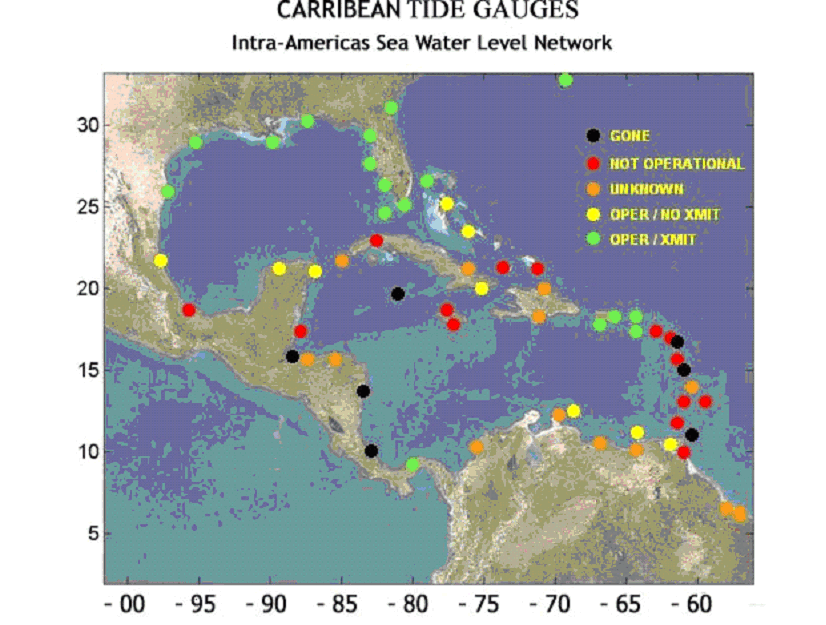SENAT
Report n° 117 (2007-2008) by M. Roland COURTEAU, Senator (for the parliament office for the evaluation of scientific and technological choices) - Appendix to the minutes of the 7 December 2007 session
Disponible au format Acrobat (21 Moctets)
b) The Caribbean: numerous obstacles to setting up an effective warning system
Since the creation of the Intergovernmental Coordination Group for the Tsunami Warning System in the Caribbean, only two meetings have taken place (in Barbados in 2006 and in Venezuela in 2007) and little progress has been made.
First of all, the Caribbean zone suffers from several disadvantages: it is a "multi-hazard" region (cyclones, earthquakes, volcanic eruptions, tsunamis) made up of many small islands and countries with meager financial and logistical resources.
Since the tsunami risk has long been ignored in this region, it is poorly equipped with measuring devices capable of detecting tsunamis and issuing reliable warning messages. Considering this zone's significant seismic risk, several seismological networks exist, even though certain regions, such as Mexico and Cuba, remain poorly covered. Ultimately, each island will have to have a seismic station, for the very rapid detection of earthquakes.
As regards the region's tide gauges, it was observed during the last meeting that 60% of these devices are out of service and that only a very few of those that do function transmit their data in real time.

Source: Puerto Rico Seismic Network
In addition, this region demands very fast reaction times. For example, a tsunami generated in the Virgin Islands will arrive in one hour and fifteen minutes in Guadeloupe, but in only 10 minutes if generated in Montserrat. Therefore, the warning system methodologies used in the Pacific region, where the distances covered are much greater, are simply not pertinent for the Caribbean zone. However, the last conference revealed that half of the zone's countries have yet to name their Focal Point.
The group's actions are considerably slowed down by the lack of financial means. The ICG/Caribbean-TWS does have at its disposal the Caribbean offices of the IOC in Cartagena (Colombia). However, contrary to the ICG/IOTWS, it does not have any personnel specifically in charge of managing its actions and, in particular, organizing local work sessions: during the last meeting of 2007, it was observed that three out of four workgroups had not met for over a year, due to a lack of funding.
Finally, one must emphasize the difficulties related to the at times difficult relations that exist between this zone's countries, which constitute significant obstacles to setting up a warning system based on the sharing of information. For example, during the meeting in Venezuela, the Venezuelan institute responsible for seismic research 37 ( * ) announced that it did not want to take part in the international tsunami monitoring system via the sharing of seismic data.
Nevertheless, the Caribbean zone does have an advantage: the presence of American territories (Puerto Rico and the Virgin Islands) and the proximity of Florida. Within the framework of its National Tsunami Hazard Mitigation Program, the United States has taken several measures originally intended to protect its own coasts, but which also benefit the entire region.
First of all, beginning in 2006, it was decided that PTWC and WC-ATWC tsunami warning centres would extend their activities to the entire zone until a regional system was set up.
Furthermore, Puerto Rico quickly emerged as the most advanced country with regard to tsunami preparedness. After launching, with the aid of the ICG/Pacific, a tsunami warning and mitigation programme in 2000, a tsunami warning system was established in 2003. Puerto Rico's seismic station was put in charge of detecting tsunami-generating earthquakes, in collaboration with PTWC.
This system has slowly but surely been improved. In 2006, the United States Geological Survey installed 9 seismological stations linked by satellite to Puerto Rico's seismic network, in order to complete the networks' coverage. Furthermore, one DART buoy was installed in the Caribbean Sea, one in the Gulf of Mexico and two north of Puerto Rico.
As a result, even if Puerto Rico's seismic network does not yet meet all the necessary conditions of a warning centre 38 ( * ) , in practice, it has been recognized as such by most countries in the region. Indeed, more than 50 broadband seismological stations in the Caribbean zone transmit their data in real time to the Puerto Rican network. During the last meeting, Puerto Rico's seismic network distributed to all participants a funding request for €815,000 addressed to the American Congress in order to ensure the operating costs of the future warning centre for the period of 2007-2010.
* 37 « La Fundación Venezolana de Investigaciones Sismológica»s (FUNVISIS).
* 38 For example, it does not function 24 hours a day, 7 days a week.







